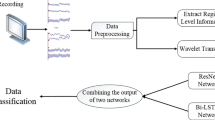Abstract
Brain–computer interface (BCI) technology based on electroencephalogram (EEG) has attracted widespread attention, among which interpretation, pattern recognition, and classification of brain activity through EEG are promising researches. However, EEG-based object classification is still confronted with enormous challenges in terms of the performance and interpretability of human brain signals. Accordingly, this paper constructs a novel hybrid dilation residual shrinkage network with Spatio-temporal feature fusion to research brain visual images classification. Inspired by visual attention and brain memory mechanisms, a hybrid dilation residual shrinkage module is designed to obtain the features of interest and reduce noise and redundant information. Then, EEG signals are encoded and stored in terms of the temporal and spatial dimensions, respectively. On the basis of the characteristics of the EEG signals, this work utilizes the gated recurrent unit network to generate temporal features and spatial features are obtained through a 2D hybrid dilation convolution module. Finally, the extracted spatio-temporal features are concatenated and then retrieved. Results indicate that the designed model is usable and effective. The proposed network achieves better classification performance compared with the existing methods.






Similar content being viewed by others
References
He, B., Yuan, H., Meng, J., Gao, S.: In Brain–Computer Interfaces, pp. 131–183. Springer (2020)
Basar, M.D., Duru, A.D., Akan, A.: Emotional state detection based on common spatial patterns of EEG. Signal Image Video Process. 14(3), 473–481 (2020)
Jordan, K.G.: Emergency EEG and continuous EEG monitoring in acute ischemic stroke. J. Clin. Neurophysiol. 21(5), 341–352 (2004)
Choubey, H., Pandey, A.: A combination of statistical parameters for the detection of epilepsy and EEG classification using ANN and KNN classifier. Signal Image Video Process. 15(3), 475–483 (2021)
Babiloni, F., et al.: Linear classification of low-resolution EEG patterns produced by imagined hand movements. IEEE Trans. Neural Syst. Rehabil. 8(2), 186–188 (2000)
Zhang, Y., et al.: Sparse bayesian classification of EEG for brain-computer interface. IEEE Trans. Neural Net. Lear. 27(11), 2256–2267 (2015)
Subasi, A., Gursoy, M.I.: EEG signal classification using PCA, ICA, LDA and support vector machines. Expert Syst. Appl. 37(12), 8659–8666 (2010)
Zheng, W.-L., Lu, B.-L.: Investigating critical frequency bands and channels for EEG-based emotion recognition with deep neural networks. IEEE Trans. Auton. Mental Dev. 7(3), 162–175 (2015)
Zhao, M., Zhong, S., Fu, X., Tang, B., Pecht, M.: Deep residual shrinkage networks for fault diagnosis. IEEE Trans. Ind. Inform. 16(7), 4681–4690 (2020)
Chung, J., Gulcehre, C., Cho, K., Bengio, Y.: Empirical evaluation of gated recurrent neural networks on sequence modeling (2014). arXiv:1412.3555
Lei, X., Pan, H., Huang, X.: A dilated CNN model for image classification. IEEE Access 7, 124087–124095 (2019)
Kapoor, A., Shenoy, P., Tan, D.: Combining brain computer interfaces with vision for object categorization, pp. 1–8. IEEE (2008)
Parekh, V., Subramanian, R., Roy, D., Jawahar, C.: An eeg-based image annotation system, 303–313 (Springer, 2017)
Amin, S.U., Muhammad, G., Abdul, W., Bencherif, M., Alsulaiman, M.: Multi-CNN feature fusion for efficient EEG classification, pp. 1–6. IEEE (2020)
Dai, M., Zheng, D., Na, R., Wang, S., Zhang, S.: EEG classification of motor imagery using a novel deep learning framework. Sensors 19(3), 551 (2019)
Spampinato, C. et al.: Deep learning human mind for automated visual classification, pp. 6809–6817 (2017). arXiv:1609.00344
Wang, P., Jiang, A., Liu, X., Shang, J., Zhang, L.: LSTM-based EEG classification in motor imagery tasks. IEEE Trans. Neural Syst. Rehabil. 26(11), 2086–2095 (2018)
Fares, A., Zhong, S., Jiang, J.: Region level bi-directional deep learning framework for EEG-based image classification, pp. 368–373. IEEE (2018)
Zhong, S.-h., Fares, A., Jiang, J.: An attentional-LSTM for improved classification of brain activities evoked by images, pp. 1295–1303 (2019)
Palazzo, S., et al.: Decoding brain representations by multimodal learning of neural activity and visual features. IEEE Trans. Pattern Anal. Mach. Intell. (2020)
Ma, X., Qiu, S., Du, C., Xing, J., He, H.: Improving EEG-based motor imagery classification via spatial and temporal recurrent neural networks, pp. 1903–1906 (2018)
Zheng, X., et al.: Decoding human brain activity with deep learning. Biomed. Signal Proces. 56, 101730 (2020)
Zheng, X., Chen, W.: An attention-based Bi-LSTM method for visual object classification via EEG. Biomed. Signal Process. 63, 102174 (2021)
Xu, G., Ren, T., Chen, Y., Che, W.: A one-dimensional CNN-LSTM model for epileptic seizure recognition using EEG signal analysis. Front. Neurosci. 14, 1253 (2020)
Ramzan, M., Dawn, S.: Fused cnn-lstm deep learning emotion recognition model using electroencephalography signals. Int. J. Neurosci. pp. 1–10 (2021)
Kuruvila, I., Muncke, J., Fischer, E., Hoppe, U.: Extracting the locus of attention at a cocktail party from single-trial EEG using a joint CNN-LSTM model. arXiv preprint arXiv:2102.03957 (2021)
Russakovsky, O., et al.: Imagenet large scale visual recognition challenge. Int. J. Comput. Vis. 115(3), 211–252 (2015)
Mukkamala, M.C., Hein, M.: Variants of rmsprop and adagrad with logarithmic regret bounds, pp. 2545–2553. ACM (2017)
El-Lone, R., Hassan, M., Kabbara, A., Hleiss, R.: Visual objects categorization using dense eeg: A preliminary study, pp. 115–118. IEEE (2015)
Zheng, X., et al.: Ensemble deep learning for automated visual classification using EEG signals. Pattern Recogn. 102, 107147 (2020)
Acknowledgements
The research was supported by the National Natural Science Foundation of China under Grant No. 62072468 and the Graduate Innovation Project of China University of Petroleum (East China) under Grant No. YCX2021120.
Author information
Authors and Affiliations
Corresponding author
Ethics declarations
Conflict of interest
The authors declare no conflict of interest.
Additional information
Publisher's Note
Springer Nature remains neutral with regard to jurisdictional claims in published maps and institutional affiliations.
Rights and permissions
About this article
Cite this article
Guo, W., Xu, G. & Wang, Y. Brain visual image signal classification via hybrid dilation residual shrinkage network with spatio-temporal feature fusion. SIViP 17, 743–751 (2023). https://doi.org/10.1007/s11760-022-02282-4
Received:
Revised:
Accepted:
Published:
Issue Date:
DOI: https://doi.org/10.1007/s11760-022-02282-4




